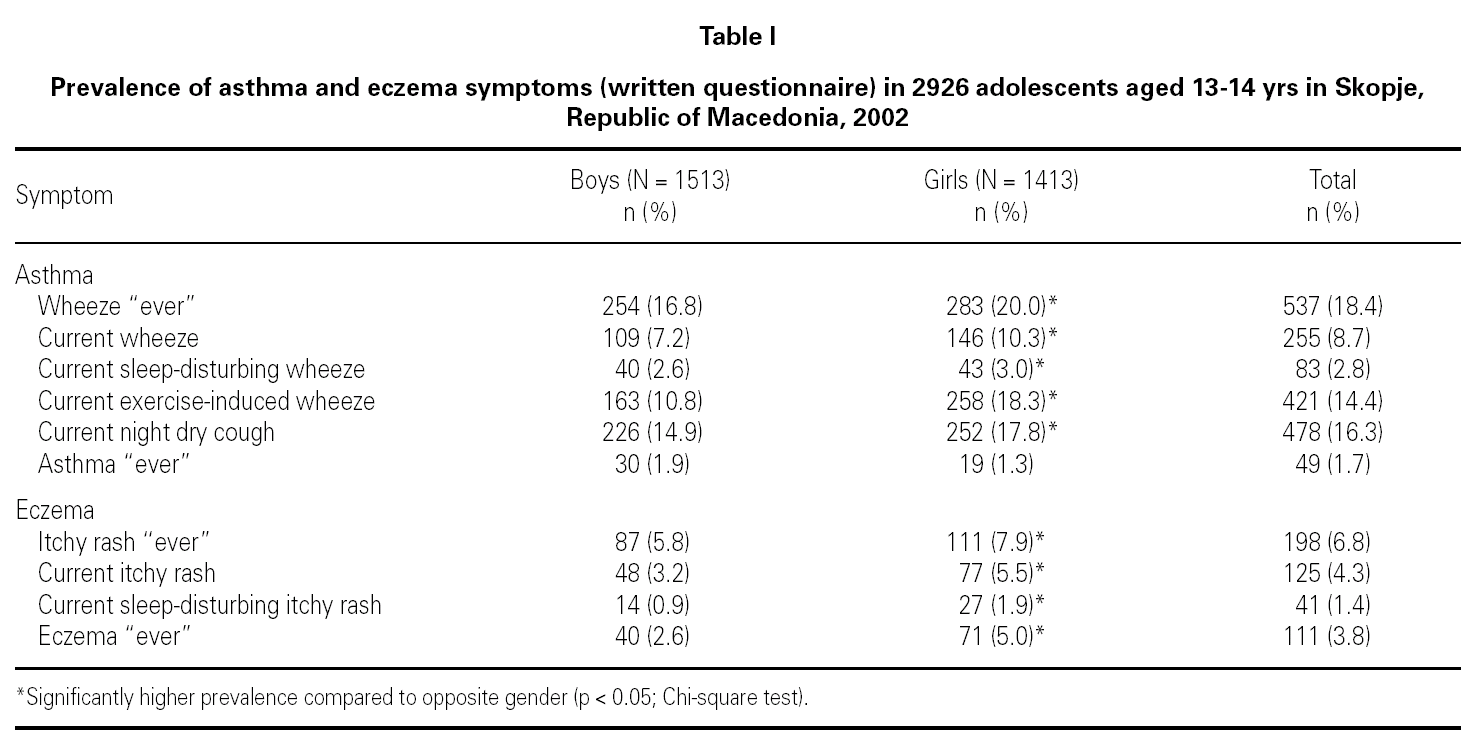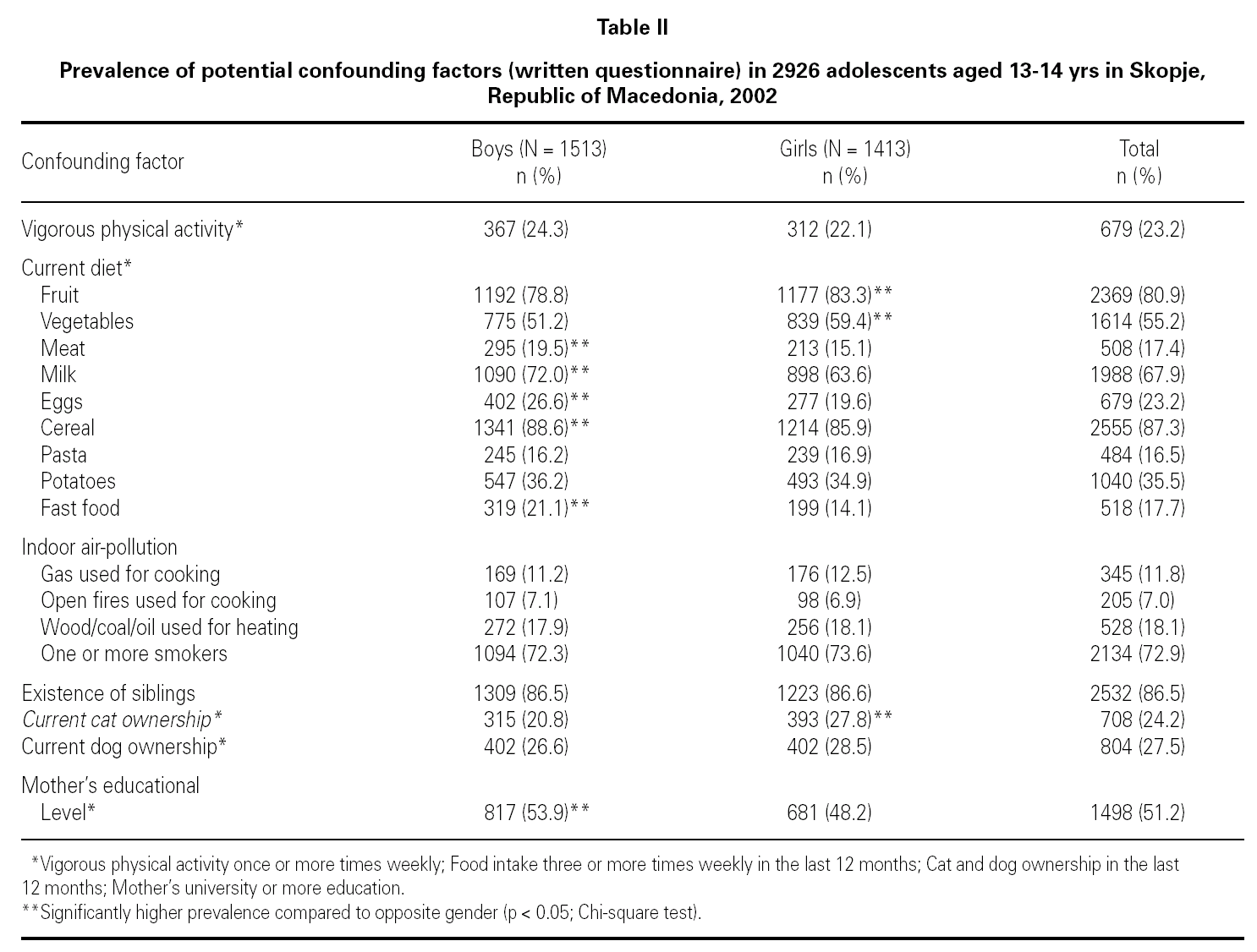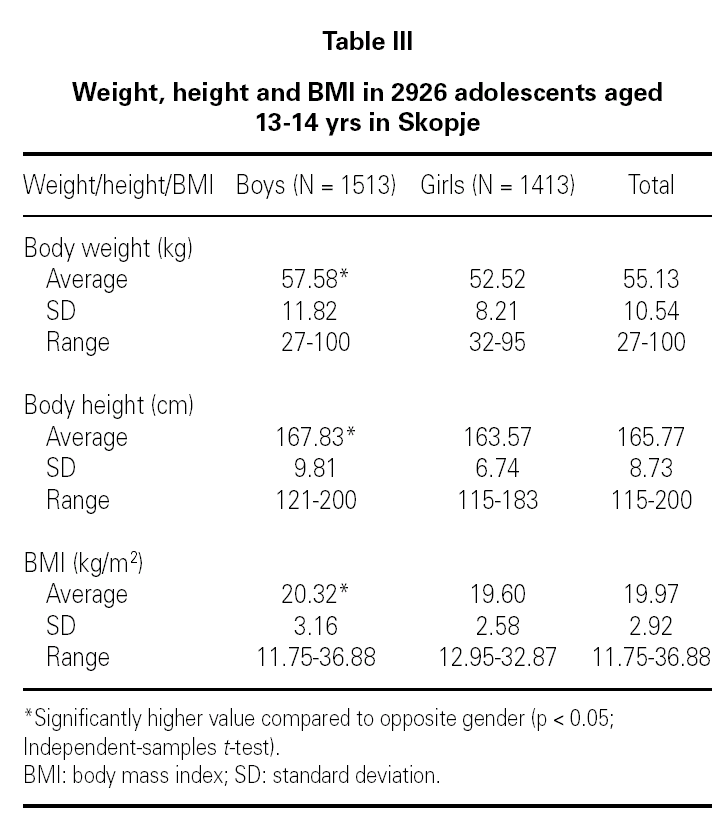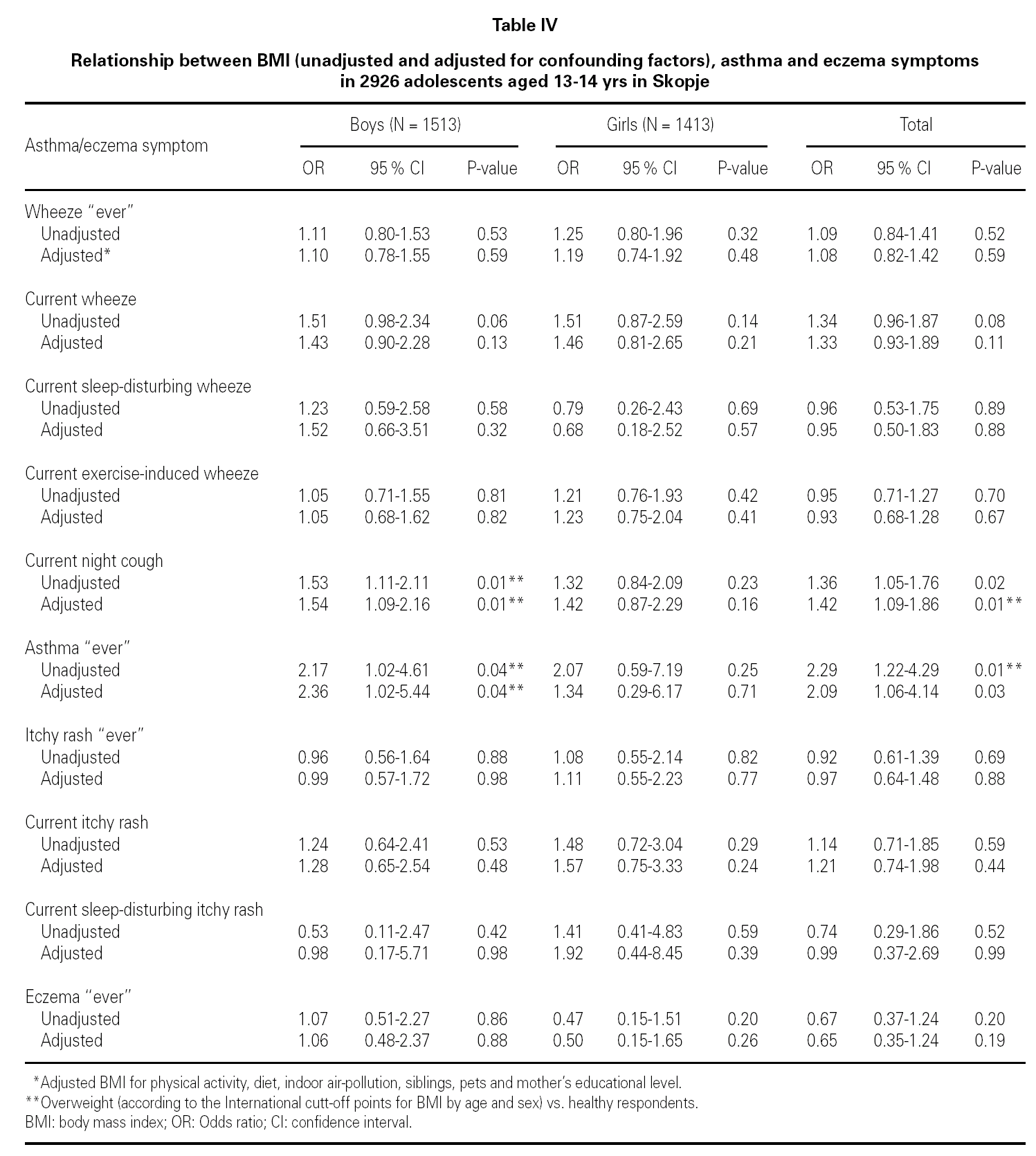INTRODUCTION
An increase in the prevalence of asthma and eczema 1-3 as well as obesity 4 in children and adolescents has been reported over recent decades. Some studies have found a strong positive association between body mass index (BMI) and asthma 5-8 being more evident in female but not in male adults 7, whereas the findings of this gender-specific relationship are inconsistent in children 5,6,8,9. The proposed underlying mechanisms of this association, although not yet well understood, are mechanical effects including airways latching, gastro-oesophageal reflux, a hormonal imbalance with elevated oestrogen levels, an immune modification, related genetic mechanisms, genetic interactions with environmental exposures (physical activity, diet), and the Barker hypothesis about foetal programming and a developmental relationship of obesity with asthma 10-12. As in adults, there may be studies in children showing no association between BMI and asthma that have not been reported. In contrast to asthma, the relationship between high BMI and eczema has been less extensively studied and has been not proven 6,7, or has been found in currently wheezy children only 13.
This study was aimed at analyzing the relationship between BMI and self-reported asthma, atopic eczema and related symptoms, as well its sex-dependence in a large sample of young adolescents aged 13/14 years in Skopje in the Republic of Macedonia, as a region with a very low prevalence of obesity and with a moderately high prevalence of current wheeze.
SUBJECTS AND METHODS
The study was cross-sectional and carried out in accordance with the International Study of Asthma and Allergies in Childhood (ISAAC) Phase Three protocol 14,15 in Skopje, the capital of Macedonia, as a part of the Macedonian arm of the third phase of ISAAC.
With the passive consent of their parents, 3026 young adolescents out of the approached 3330 from 17 randomly selected schools self-completed, under the supervision of the project team, the ISAAC written core questionnaires on asthma, eczema and the environmental questionnaire. The follow-up visit of each school where absentees were registered on the first visit, after a period of 2-3 weeks was realized. A response-rate of 90.9 % was achieved. As an inclusion criterion the 13/14-year-old age group was used. The data collection was conducted outside of the main pollen season 14, during the period from December 2001 to March 2002.
Outcome measures used in this study were the prevalence rates of asthma and atopic eczema symptoms at any time in the past (wheeze "ever" and itchy rash "ever") as well as 12-month prevalence of symptoms of asthma (current wheeze, current exercise-induced wheeze, current night dry cough not due to a cold or chest infection) and symptoms of atopic eczema (current itchy rash). These outcome measures were obtained from core questions about the presence of wheezing or whistling in the chest at any time in the past and in the last 12 months, and about the presence of an itchy rash which was coming at going for at least 6 months at any time in the past and in the last 12 months. Severity of asthma and atopic eczema symptoms was assessed among respondents with current wheeze or current itchy rash based on the responses to questions about sleep disturbance due to wheeze (current sleep-disturbing wheeze) or interference with sleeping because of the itchy rash (current sleep-disturbing itchy rash). Severity indices were subcategorized into "none" and "any". Finally, information related to lifetime diagnosis of asthma and atopic eczema was obtained from answers to questions about ever having had doctor-diagnosed asthma or eczema (asthma "ever" or eczema "ever") 2,14,16,17.
Self-reported weight and height or, where unknown, their measured values were used for the calculation of the BMI of each respondent as weight (kg)/height (m) 2. The International cut-off points for BMI for overweight and obesity by sex between 2 and 18 years, defined to pass through a BMI of 25 kg/m 2 for overweight and 30 kg/m 2 for obesity at age 18, were used 18.
The vigorous physical activity during a week, different food intake per week in the last 12 months (current diet), indoor air-pollution (gas and open fires usually used for cooking, wood/coal/oil as fuel usually used for heating, one or more smokers in the house), existence of siblings (younger and older), cat and dog ownership in the last 12 months (current cat and dog ownership) and mother's educational level, as factors which may influence overweight or are associated with sedentary regimen, were all used as confounding factors for BMI adjustment.
As 100 respondents (3.3 %) were excluded from the analysis because of missing data on weight and/or height, the total analysed group consisted of 2926 respondents. Out of them, 1513 (51.7 %) were boys and 1413 (48.3 %) were girls. Their average age was 13.45 years (SD 0.50) for both boys and girls.
The group of respondents with obesity consisted of 45 children (1.5 %) only, with predominance in boys (86.7 %), and these were included in the overweight group. In 442 respondents (15.1 %) BMI was over the cut-off point by age and sex for overweight. Of the latter, 323 respondents (73.1 %) were boys.
Ethical approval
The Ethics Committee at the Medical Faculty and The Ministry of Education and Science, Skopje, the Republic of Macedonia, approved the conduct of the ISAAC Phase Three in the Republic of Macedonia.
Statistical analyses
A chi-square test was conducted to test for statistical significance in the comparison of the prevalence between boys and girls of asthma symptoms, atopic eczema symptoms and potential confounding factors. Weight, height and BMI between boys and girls were compared using the independent-samples t-test.
The relationship between BMI both unadjusted and adjusted for potential confounding factors and asthma and eczema symptoms, as dependent variables, by odds ratios with 95 % confidence interval (OR, 95 % CI) in binary logistic regression in SPSS 11.0 for Windows was analysed. The BMI under the cut-off point for overweight by sex and age was used as a referent category in statistical analysis.
A resulting p-value of < 0.05 was considered significant.
RESULTS
The established prevalence rates of wheeze "ever" and current wheeze were much higher compared to the prevalence rate of reported asthma "ever" for both boys and girls. There was not a big difference between the prevalence of current sleep-disturbing wheeze, as a parameter of asthma severity, and the prevalence of reported asthma "ever". Regarding the corresponding prevalence rates of eczema, such differences were not found. All asthma symptoms and atopic eczema occurred more frequently in girls than in boys, while the opposite was true for reported asthma "ever" (table I).
A significantly higher frequent intake of meat, milk, eggs, cereals and fast food in boys compared to girls was determined, while the frequent intake of fruit and vegetables was significantly higher in girls than in boys. Girls had more often a cat in the house and boys had more often mother with advanced education (chi-square test) (table II).
A significantly higher body weight, body height and BMI in boys compared to girls with independent-samples t-test were detected (table III).
The relationship between BMI and asthma and eczema symptoms is shown in table IV. Current night dry cough not due to a cold or chest infection and reported asthma "ever" were positively associated with overweight in boys and the significance remained after adjustment for potential confounding factors (p = 0.01 and p = 0.04, respectively).
DISCUSSION
In the present study, a significant positive association was determined between overweight and current night dry cough not due to cold or chest infection and reported asthma "ever", in the whole group of young adolescents investigated as well as in the male group alone. Night dry cough is considered to be a non-specific asthma symptom 19, but overweight was positively associated with reported asthma "ever" also, which makes the established positive association more confident. The determined male-specific positive association may be due to the predominance of overweight and obesity in our male respondents (73.1 % and 86.7 %, respectively) 20, which may be explained by significantly higher intake of cereals and fast food in boys. The possibility of a higher degree of physical activity among boys and therefore a greater likelihood of discovering their asthma symptoms 13 seems an unlikely explanation as the prevalence of all asthma symptoms, including current night cough, is significantly higher in our female respondents and the rate of a vigorous physical activity is almost the same in both sexes (tables I and II).
Gilliland et al 8, in a longitudinal study of school-age children, have found that being overweight is associated with an increased risk of new-onset asthma in boys, in contrast to a stronger positive association between BMI and asthma attacks in the previous year, occasional wheeze or persistent wheeze in 4-11 year old girls than in boys in the inner-city sample and to a positive association in both sexes in the representative sample reported by Figueroa-Muñoz and colleagues 5. A female-specific positive association between BMI and wheeze "ever", cough or atopy in children aged 7-12 years is reported by Schachter et al 19 also, but it was not detected regarding asthma or airway hyper-responsiveness in either boys or girls. Mai et al 13 have established a positive association of BMI with current wheeze, asthma severity and eczema in currently wheezy children only, while von Kries et al 6, using ISAAC questionnaires in children 5-6 year old, have reported a female-specific association of high BMI with doctor-diagnosed asthma and no association with eczema in either sex. In the abovementioned studies on female dependence of the association in children, the authors have concluded that a satisfactory explanation for such prepubertal sex dimorphism was unavailable 5 or the findings have been explained by the possible effect of differences in hormonal levels, inflammatory markers or body fat distribution 19, by the possibility of higher rates of dyspnoea and "asthma-like symptoms" related to physical activity in obese girls or by reduced airways-calibre as a result of the specific fat deposition in girls 6. Gilliland et al 8 have suggested that the inconsistency of results for boys and girls between studies might be a consequence of chance, differences in study populations, the age distribution of respondents, unrecognised confounding or effect modification.
A significant association of being overweight with asthma symptoms other than current night cough and reported asthma "ever" as well as with atopic eczema, was not established in our study. Although the study was not designed to examine the underlying mechanisms of the relationship between BMI and the investigated allergic diseases, related to the already postulated hypotheses 10-12, the results may suggest alterations in airway mechanics and/or gastro-oesophageal reflux as possible mechanisms of the positive association determined between overweight and night cough and reported asthma "ever". Mechanical factors, i.e. decreased tidal excursion leading to smooth airway muscle-latching and to increased airways-responsiveness and gastro-oesophageal reflux that is associated with both overweight and asthma, are some of the suggested underlying mechanisms of the association between high BMI and asthma 10. However, as in other cross-sectional studies, reverse causality as an explanation cannot be excluded 5, although longitudinal data suggest that increases in BMI may predict the development of asthma in children 8 and that moderate weight-loss improves airway obstruction and peak flow variability in obese asthmatics 21.
Chinn & Rona 22, following an analysis of the data from the National Study of Health and Growth in British children aged 5-11 years, have considered obesity as a marker of recent lifestyle differences that are associated with both asthma and obesity. The conclusion of a recent report of two cross-sectional surveys performed in 1989 and 2000 in New Zealand 23 supported some evidence for an association of obesity with asthma symptoms and treatment, which did not explain the increased prevalence of asthma. Finally, Schaub & von Mutius 12 in their review on this topic summarize evidence of a positive association between BMI and the development of asthma and conclude that, although the proposed underlying mechanisms are not yet well understood, weight-reduction is an indispensable public health strategy and that it remains to be seen whether the prevalence of asthma will also be affected.
The present study has several potential limitations. As with other questionnaire-based studies, there is a possibility of information bias. The majority of the weight and height data in our 13/14-year-old respondents is self-reported, and BMI is not considered to be the best measure of obesity in children 24. Although several studies in adolescents have demonstrated a low correlation between self-reported and measured heights and weights 25,26, an extreme reliability of self-reported heights and weights for the predicting obesity-related morbidities and behaviours has been determined 27. Furthermore, a strong correlation between BMI calculated from self-reported versus measured weight and height in a large sample of American teenagers has been found, with a conclusion that studies can use self-reported height and weight to understand teen obesity and its correlates/sequelae 28. Regarding BMI, it is widely used as an indicator of fatness and Figueroa-Muñoz and colleagues 5 have shown that it might be a better measure than skin-fold thickness for assessing the association between asthma and obesity in children because obese children had proportionally heavier muscles and bones and calliper measurements were somewhat less repeatable than height and weight measurements. Additionally, as Macedonia does not have its own reference curves, International cut-off points for BMI for overweight and obesity were used and these might differ from the real ones that apply in our country. Furthermore, if obesity, which was evident in 1.5 % of our respondents only who were therefore included in the overweight group, had had a higher prevalence and had been considered, maybe it would have been more strongly associated with other asthma or eczema symptoms 22. However, the prevalence of obesity was very low, although the prevalence of current wheeze was found to be moderately high compared to other countries worldwide 29. A diagnostic bias for doctor-diagnosed asthma due to a possibly higher rate of dyspnoea and "asthma-like symptoms" in children with high BMI 6 does not appear to be a very likely explanation of our findings since they were related to boys only and intermittent asthma seems to be under-diagnosed rather than over-diagnosed in our respondents (table I).
In conclusion, the self-reported data on young adolescents in the Republic of Macedonia, a country with a very low prevalence of obesity and a moderately high prevalence of current wheeze, showed a male-specific positive association between overweight and current night dry cough and ever-diagnosed asthma without any association regarding other asthma symptoms or atopic eczema. On the basis of previously postulated hypotheses, we speculate that alterations in airway mechanics and/or gastro-oesophageal reflux are possible underlying mechanisms of the established association.
ACKNOWLEDGMENTS
The authors would like to thank young adolescents for their participation in the survey and principals, psychologists, teachers from the selected schools for their collaboration. We wish to express our gratitude to Professor Luis Garcia-Marcos (Institute of Respiratory Health, The University of Murcia, Spain) and to Mrs. Philippa Ellwood (Department of Paediatrics, The University of Auckland, New Zealand) for helpful advices. The Ministry of Education and Science of the Republic of Macedonia provided financial support for the study.
Correspondence:
E. Vlaski, MD
Department of Pulmonology and Allergology
University Children's Hospital. Faculty of Medicine
Vodnjanska 17, 1000 Skopje
The Republic of Macedonia
E-mail: vlaskie@sonet.com.mk












